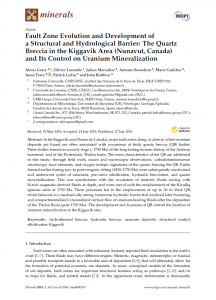Fault Zone Evolution and Development of a Structural and Hydrological Barrier: The Quartz Breccia in the Kiggavik Area (Nunavut, Canada) and Its Control on Uranium Mineralization
Alexis Grare 1,*, Olivier Lacombe 1, Julien Mercadier 2, Antonio Benedicto 3, Marie Guilcher 2, Anna Trave 4, Patrick Ledru 5 and John Robbins 5
1Sorbonne Université, CNRS-INSU, Institut des Sciences de la Terre de Paris, ISTeP UMR 7193, F-75005 Paris, France
2Université de Lorraine, CNRS, CREGU, GeoRessources lab, 54506 Vandoeuvre-lès-Nancy, France
3UMR Geops, Université Paris Sud, 91405 Orsay, France
4Departament de Mineralogia, Universitat de Barcelona (UB), Petrologia i Geologia Aplicada, Facultat de Ciències de la Terra, 08028 Barcelona, Spain
5Orano Canada Inc., 817 45th Street, West Saskatoon, SK S7L 5X2, Canada
Abstract
In the Kiggavik area (Nunavut, Canada), major fault zones along, or close to, where uranium deposits are found are often associated with occurrence of thick quartz breccia (QB) bodies. These bodies formed in an early stage (~1750 Ma) of the long-lasting tectonic history of the Archean basement, and of the Proterozoic Thelon basin. The main characteristics of the QB are addressed in this study; through field work, macro and microscopic observations, cathodoluminescence microscopy, trace elements, and oxygen isotopic signatures of the quartz forming the QB. Faults formed earlier during syn- to post-orogenic rifting (1850–1750 Ma) were subsequently reactivated, and underwent cycles of cataclasis, pervasive silicification, hydraulic brecciation, and quartz recrystallization. This was synchronous with the circulation of meteoric fluids mixing with Si-rich magmatic-derived fluids at depth, and were coeval with the emplacement of the Kivalliq igneous suite at 1750 Ma. These processes led to the emplacement of up to 30 m thick QB, which behaved as a mechanically strong, transverse hydraulic barrier that localized later fracturing, and compartmentalized/channelized vertical flow of uranium-bearing fluids after the deposition of the Thelon Basin (post 1750 Ma). The development and locations of QB control the location of uranium mineralization in the Kiggavik area.
Keywords: hydrothermal breccia; hydraulic breccia; uranium deposits; structural control; silicification; Kiggavik
